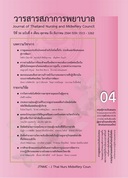สมรรถนะและเส้นทางความก้าวหน้าในงานของพยาบาลที่ปฏิบัติงานในระบบราชทัณฑ์ของไทย: โอกาสในการพัฒนา
คำสำคัญ:
สมรรถนะ, เส้นทางความก้าวหน้าในงาน, พยาบาลเรือนจำ, ผู้ต้องขัง, เรือนจำบทคัดย่อ
เรือนจำเป็นชุมชนที่มีผู้ต้องขังมาอยู่ร่วมกันจำนวนมากและมีปัญหาสุขภาพทั้งโรคประจำตัวที่มีอยู่เดิมและโรคที่เกิดขึ้นภายหลังเข้ามาอยู่ในเรือนจำ จึงมีความต้องการการดูแลด้านสุขภาพทุกมิติทั้งการส่งเสริมสุขภาพ การป้องกันโรค การรักษาพยาบาล และการฟื้นฟูสภาพพยาบาลที่ปฏิบัติงานในเรือนจำมีบทบาทสำคัญในกำรจัดบริการสุขภาพแก่ผู้ต้องขัง จึงต้องมีสมรรถนะในการปฏิบัติงานที่เฉพาะ นอกเหนือจากสมรรถนะหลักและสมรรถนะเชิงวิชาชีพทั่วไป รวมถึงควรมีความเข้าใจด้านจริยธรรม กฎหมาย และมีความสามารถในการประสานงานกับเจ้าหน้าที่ราชทัณฑ์ฝ่ายอื่นเพื่อจัดบริการด้านสุขภาพแก่ผู้ต้องขัง พยาบาลจึงควรได้รับการเตรียมความพร้อมให้มีสมรรถนะเฉพาะทางเพื่อตอบสนองต่อการดูแลสุขภาพผู้ต้องขังที่มีปัญหาสุขภาพซับซ้อนและอยู่ในสภาพแวดล้อมที่เสี่ยงต่อการเกิดโรคมากกว่าบุคคลภายนอก และควรมีการกำหนดเส้นทางความก้าวหน้าในงานที่ชัดเจนสำหรับพยาบาล
บทความนี้นำเสนอประเด็นเกี่ยวกับสภาพการทำงานของพยาบาลที่ปฏิบัติงานในเรือนจำ สมรรถนะที่จำเป็นสำหรับพยาบาลที่ปฏิบัติงานในเรือนจำ เส้นทางความก้าวหน้าในงานของพยาบาลที่ปฏิบัติงานในเรือนจำ โดยได้เสนอแนะแนวทางการพัฒนาสมรรถนะและเส้นทางความก้าวหน้าในงานของพยาบาลที่ปฏิบัติงานในเรือนจำทั้งระดับนโยบายระดับหน่วยงาน และระดับบุคคล เพื่อพัฒนาพยาบาลให้มีศักยภาพเพียงพอ มีขวัญและกำลังใจที่ดีในการปฏิบัติงานในเรือนจำต่อไป
Downloads
เอกสารอ้างอิง
Medical Services Division, Department of Corrections. Statistics of illness inmates in prison and statistics of
medical referral for sick inmates in past 5 years B.E. 2559-2563. Medical Treatment Promotion Section. 2021 [cited 2021 Feb 1] (in Thai)
Medical Services Division, Department of Corrections. Statistics of cause of illness inmates in prison in B.E.
Medical Treatment Promotion Section. 2020 [cited 2021 Feb 1] (in Thai)
Vajasara K, Prapavadee O, Ratcharoenkajohn S, Krabuansaeng J. Getting sick behind bars: health issues and prison health care. Bangkok: Duen Tula Publishing House; 2018. (in Thai)
Puektes S, Sawasdipanich N, Khasemophas D, Lohacheewa S, Thongpaiboon P, Rojanaprasert P, et al. Analysis of approaches to improving the healthcare facility for women’s inmates. Thai Journal of Nursing Council 2017;32(1):94-114. (in Thai)
Sawasdipanich N, Puektes S, Sriyaporn A, Chawmathagit C. Work experience of nurses in Thai correctional system. Thai Journal of Nursing Council 2015;30(3): 39-53. (in Thai)
Moroney MK. Caring and custody: Two faces of the same reality. J Correct Health Care 2005;1(2):157-69.
Almost J, Doran D, Ogilvie L, Miller C, Kennedy S, Timmings C, et al. Exploring work-life issues in provincial
corrections setting. J Forens Nurs 2013;9(1):3-13.
Dhaliwal K. Caring in correctional nursing: a systematic search and narrative synthesis. J Forens Nurs 2016;
(1):5-12.
Gonzalez-Galvez P, Sanchez-Roig M, Coll Camara A, Canet Velez O, Roca Llobet J. Ethic conflicts in nursing
care in the prison context. Rev Esp Sanid Penit 2018; 20:95-102.
Saraban J. Medical referral for sick prisoners. Public Health & Health Laws Journal 2018;4(2):267-78. (in Thai)
Marrelli AF, Tondora J, Hoge M A. Strategies for developing competency models. Admin Pol Ment Health 2005;32(5):533-61.
Fey MK. Miltner RS. A competency-based orientation program for new graduate nurses. JONA 2000; 30(3):126-32.
International Council of Nurses. Position statement: nurses’ role in the care of detainees and prisoners. Geneva, Switzerland; 2011.
American Nurses Association. Correctional nursing scope and standards of practice. 2nded. Silver Spring,
MD: American Nurses Association; 2013.
Royal College of Nursing. Competence Framework: Health & Justice Sector. [cited 2021 Jan 11]; Available
from: https://www.england.nhs.uk/south/wp content/ uploads/sites/6/2017/03/health-justice-competence-framework.pdf
Sancchez-Roig M. Coll-Camara A. Prison nursing and its training. Rev Esp Sanit Penit 2016;18:110-18.
Thailand Nursing and Midwifery Council. Core competencies of registered nurses. [Internet]. 2018 [cited 2021 April 2]. Available from: https://www.tnmc.or.th/004.pdf (in Thai)
Srisatidnarakul B. Leadership and strategy management in nursing organization for the twenty first century.
nd ed. Bangkok: Chulalongkorn University Printing House; 2008. (in Thai)
Human Resource Administration Division, Department of Corrections. Transfer and turnover rate of nurses
in correctional system past 3 years B.E. 2561-2563. Human Resource Administration Division. 2021 [cited 2021 Feb 10] (in Thai)
Perry J, Bennett C, Lapworth T. Education and career opportunities for nurses in offender health care. Nurs Stand 2010;24(43):35-9.
Shelton D, Barta B, Reagan LA. Correctional nurse competency and quality care outcomes. JEPCH 2018;2(1):73-98.
Sawasdipanich N, Puektes S, Wannasuntad S, Sriyaporn A, Chawmathagit C, Sintunava J, Paungsawad G.
Development of healthcare facility standards for Thai female inmates. Int J Prison Health 2018;14(3): 163-74.
United Nation Office on Drugs and Crime. United nation standard minimum rules for the treatment of prisoners (the Nelson Mandela Rules). Justice Section, Division for Operations Vienna International Centre. [cited 2021 Feb1]; Available from: https://www.unodc.org/documents/justice- and-prison-reform/ Nelson_Mandela_Rules-E-ebook.pdf
Enhancing Lives of Female Inmates Project, Office of Justice Affairs, Ministry of Justice. United Nations rules for the treatment of women prisoners and non-custodial measures for women offenders (the Bangkok Rules). Bangkok: Bophit Printing; 2010. (in Thai)
Shelton D, Weiskopf C, Nicholson M. Correctional nursing competency development in the Connecticut
correctional managed health care program. J Correct Health Care 2010;16(4):299-309.








